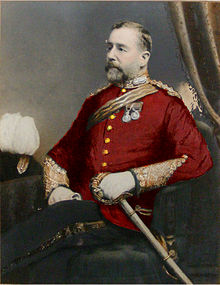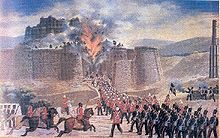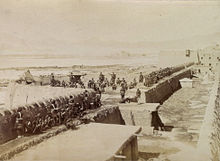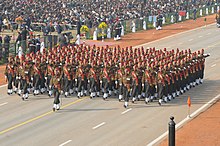|
Bengal Engineer Group
The Bengal Engineer Group (BEG) (informally the Bengal Sappers or Bengal Engineers) is a military engineering regiment in the Corps of Engineers of the Indian Army. The unit was originally part of the Bengal Army of the East India Company's Bengal Presidency, and subsequently part of the British Indian Army during the British Raj. The Bengal Sappers are stationed at Roorkee Cantonment in Roorkee, Uttarakhand. The Bengal Sappers are one of the few remaining regiments of the erstwhile Bengal Presidency Army and survived the Rebellion of 1857 due to their "sterling work" in the recapture by the East India Company of Delhi and other operations in 1857–58. The troops of the Bengal Sappers have been a familiar sight for over 200 years in the battlefields of British India with their never-say-die attitude of Chak De and brandishing their favourite tool the hamber.[3][4][5] Over the years the Bengal Sappers have won 80 battle and 11 theatre honours, 11 Victoria Cross, 117 Indian Order of Merit, 24 Shaurya Chakra, 190 Sena Medals and 11 Arjuna Awards, the highest number of won by any single organization in the country.[3][6] Lt Gen Joginder Singh Dhillon was commissioned into Bengal Engineer Group in 1936 and commanded the First Republic Day Parade in New Delhi,[citation needed] becoming the first army officer to be awarded the Padma Bhushan in November 1965.[7] Among the three Sapper units of the Indian Army, the Bengal Sappers was the first engineer group to receive the 'President Colours' in recognition of its service to the nation, on 12 January 1989, by Ramaswamy Venkataraman, the eight President of India, who presented the Regimental Colours to Bengal Engineer Group at Roorkee.[5] Besides service on the battlefield, the Bengal Engineers also rendered valuable peacetime contributions. The military engineer Lt. James Agg designed St John's Church, Calcutta. It was based on James Gibbs's St Martin-in-the-Fields in London and was consecrated in 1787.[8] St John's was the Anglican cathedral of the city – capital of the Bengal Presidency – until St Paul's Cathedral, begun 1839, was completed in 1847.[9] St Paul's was also designed by a Bengal Engineer, William Nairn Forbes, who was also architect of the "Old Silver Mint" building at the India Government Mint, Kolkata, basing its portico on the Parthenon on the Acropolis of Athens.[9]  HistoryThe Indian Army Corps of Engineers is one of the oldest arms of the Indian Army, dating back to 1780, when the two regular pioneer companies of the Madras Sappers were raised, as a part of the East India Company's army.[10] Prior to its formation, by 1740s officers and engineers from the Kingdom of Great Britain served in the Bengal Engineers, Bombay Engineers and Madras Engineers, formed with the respective Presidency armies, while British soldiers served in each of the Presidencies' engineering companies, namely the Madras Sappers and Miners, Bombay Sappers and Miners, and the Bengal Sappers and Miners.[11][12] The Bengal Sappers and Miners was originally the Corps of Bengal Pioneers, which was raised from two pioneer companies in 1803, part of Bengal Army of the Presidency of Bengal; one raised by Capt T. Wood at Kanpur as Bengal Pioneers in November 1803,[4] also known as "Roorkee Safar Maina".[13] In 1819, at the conclusion of Third Maratha War, a part of Bengal Pioneers merged with the Company of Miners (raised in 1808) to become the Bengal Sappers and Miners, and raised at Allahabad, with Captain Thomas Anburey as the Commandant. The remaining part of the Corps of Bengal Pioneers was absorbed in 1833.[4] In 1843 'Broadfoot's Sappers', which had been raised in 1840, merged into the Bengal Sappers and Miners. In 1847 the Bengal Sappers and Miners was renamed Bengal Sappers and Pioneers, and in 1851 it became the Corps of Bengal Sappers and Miners. On 7 November 1853, the regiment moved to Roorkee, where it has maintained its regimental centre ever since.[14] Lord Kitchener of Khartoum's 1903 Kitchener Reforms saw it re-designated as the 1st Sappers and Miners, which was again altered in 1906 to the 1st Prince of Wales's Own Sappers and Miners. On the accession of George V to the throne in 1910 it was renamed 1st King George V's Own Bengal Sappers and Miners,[15] with the '1st' being dropped in 1923, to make it King George V's Own Bengal Sappers and Miners. In 1937 it was renamed King George V's Bengal Sappers and Miners, and in 1941 they became the 'King George V's Bengal Sappers and Miners Group of the Indian Engineers'. In 1946 it became the 'King George V's Group' of the Royal Indian Engineers. On Indian independence and partition in 1947, about half of the serving personnel were allocated to the Pakistan Royal Engineers. Corps of Engineers, after which they became the Bengal Engineer Group and Centre.The first Indian to be awarded the Indian Order of Merit gallantry award, Sub Devee Singh was a Bengal Sapper.The first World War saw the Bengal Sappers in action in Aden, Egypt, Palestine, Mesopotamia, Persia and France. The second World War saw them excel in North Africa, Italy, Malaya and Burma. For their courage and acts of valour, soldiers personnel of the Group were awarded a total of 39 Military Cross, 7 Indian Order of Merit, 22 Indian Distinguished Service Medal, and 42 Military Medal and the units of the Group won a host of battle honours. In 1950 the Bengal Centre Corps of Engineers participated in Jammu and Kashmir operations of 1948, Goa operations of 1961, Chinese war of 1962 and the Indo-Pak War of 1965 saw the Bengal Sappers Regiment at their very best with improvisation and innovation and these proved invaluable in the achievement of ultimate victory. Units of the Bengal Sappers rose magnificently to the demands made of them during the 1971 operations leading to the liberation of Bangladesh and the dismemberment of Pakistan. In many literatures, the operations in Bangladesh are best described as an "Engineers War", since ultimate victory depended to a large extent on the timely and skillfully executed passages of our forces across the innumerable obstacles in the riverine terrain of what was East Pakistan. The group units has also participated in major operations like "Operation Pawan, Operation Meghdoot, Operation Rakshak, Operation Parakram and Operation Snow Leopard. The creation of India and Pakistan in 1947 was one of the most trying periods in the history of the Group. When existing assets of the Army were ordered to be shared on a two third-one third basis between India and Pakistan, the assets of Bengal Engineer Group were allotted to the Royal Pakistan Engineers. The greater part of the British Officers and units of the group, regimental funds and equipment thus went to Pakistan. The responsibility of the group fell to Col JS Dhillon, the first Indian Commandant who during the 1965 operations against Pakistan distinguished himself and moulded the Corps back into a supremely fit Sapper Group. When Pandit Jawaharlal Nehru visited Roorkee in November 1949, he was so impressed by the achievements of the Bengal Sappers Centre that he chose Brig JS Dhillon to lead the first Republic Day parade in 1950. In present day, Sappers are required in Indian Army operations to assist the infantryman to victory by using technical skills and resources to overcome an enemy entrenched behind seemingly impregnable and impassable obstacles or fortifications. They assist and maintain the tactical mobility of our own forces during war by quickly making bridges, roads, airfields and railways, often in the face of the enemy. They impede the enemy's mobility by laying minefields, demolishing bridges, cratering roads and blowing up logistic installations. The Sappers carry out a host of associated functions like provision of accommodation for troops and equipment upto the remotest areas, water supply and sanitation to ensure the Army's well-being. It is but natural that Sappers with such capabilities also provide aid to Civilian authorities during natural calamities like floods, earthquakes and maintenance of essential services. The troops of the Bengal Sappers have been a familiar sight for over 200 years in the battlefields of British India and post-Independence operations with their never-say-die attitude and living up to their motto of Sarvatra. [16] Battle honours Colonial India

Republic of India
Victoria Cross recipients
See alsoCitations
BibliographyShort Histories:
First World War:
Second World War:
External links |
||||||||||||||||||||||||||||||||||||||||||||||||||||||||||||||||||||||||||||||||||||
